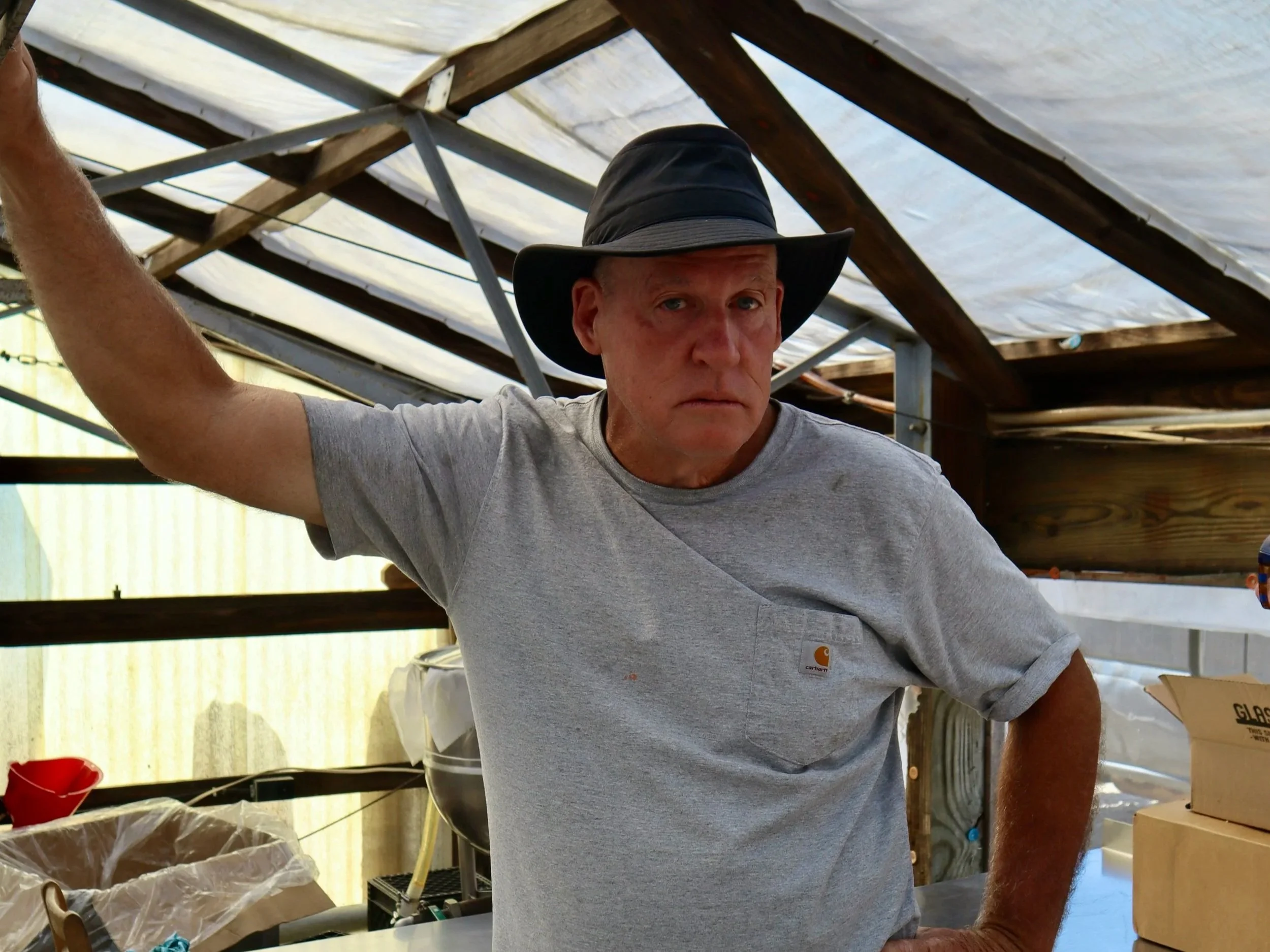Cooking Sorghum with Randal Rock
story by Donna Hecker & photography by Talitha Schroeder
Squeezing, boiling, skimming, straining, cooling, bottling. Roaring, hissing, bubbling. Making sorghum molasses is rough business. But the end result? As they say in far-off New Zealand, when life is good, it’s “sweet as.” And so is Kentucky sorghum.
The sorghum we use in our Holly Hill restaurants comes from Randal Rock who bottles it under the Country Rock label. Randal and his partner Curtis Congleton harvest sweet sorghum every fall to boil into molasses. Not wanting to miss this year’s boiling, I texted Randal on September 2 to see if he’d started cutting and pressing yet.
His answer was curt, “end of September, I hope. Pray for rain.” Well, after several long, hot and dry weeks, we finally did get a bit of rain and sure enough, Randal wrote back on the last day of the month to say they’d be cooking that week.
A quick culinary history lesson – all sorghum is molasses but not all molasses is sorghum. Most of the molasses on your grocery store shelf is a by-product of sugar production, whether from sugar cane or sugar beets. Sorghum molasses is the juice of the sweet sorghum plant, boiled down to a thick syrup.
There are several types of sorghum, including grain sorghum which can be cooked like other cereals, and broomcorn, which the Shakers transformed into their signature flat brooms. The day we visited, Randal and Curtis were boiling juice from a sweet variety named Dale.
Randal once warned me that if anyone ever said Abe Lincoln cut sorghum as a kid, they were lying. Although it’s been planted in America since colonial times, sorghum didn’t become widely popular until the 1850s when it emerged as a cheaper alternative to sugarcane. And then became even more valuable during the Civil War when trade on the Mississippi River was embargoed.
Like so many of our culinary riches, sorghum came to Kentucky, as to all of North America, from the African continent. According to food historian Michael Twitty, it was known as “Guinea corn” and its cultivation often centered around settlements of enslaved people. He went on to write that at least one variety can be traced to a cultivar known as imphee, with roots in the Zulu empire.
To be processed into molasses, sorghum stalks are shorn of their seedy locks and fed through a mill (usually motorized/sometimes mule-driven) to extract the juice. Randal likes to squeeze when the juice contains at least 18% sugar, and he cut into a stalk to show us how to take a Brix measurement.
The freshly squeezed juice is collected in a repurposed milk cooler to allow the solids to settle before the juice is preheated to 190℉ on its way to the evaporator pan. The 225 gallons of juice in the preheater tank will cook down to about 35-40 gallons of finished molasses, depending on the sugar content of the juice. More sugar equals faster evaporation and better yield.
Randal explained how the evaporator pan is deeper at the end where the juice enters and shallower at the other. It’s also tilted so the juice, like salmon scaling ladders, has to move uphill and pass through a series of channeled steel baffles.
While all this is going on, someone has to constantly skim the boiling syrup to remove the impurities that rise to the top. We still hear stories today from folks who, as little children, were treated to cups of “the skimmings” when their elders gathered to cook molasses.
As the juice thickens and reaches the other end of the pan, some say it’s “smoking its pipe.” Or as Randal puts it, making “sheep’s eyes” bubbles. By now, it’s reached about 240 ℉ and is officially molasses. Randal strains the amber elixir through a couple layers of mesh into an old milk can, then transfers it to a double-walled kettle for further cooling.
We use it by the gallon but Randal also packs his Country Rock sorghum into jars and plastic bottles. The uses are infinite – from smushing with soft butter for spreading on hot biscuits, to baking into Sorghum Crinkle Cookies (thank you Rona Roberts!), even whisking into salad dressings like our classic sorghum vinaigrette.
You could make an old-fashioned treat called egg butter (there’s a recipe in Rona’s Sweet, Sweet Sorghum), or popcorn balls. Or you could just savor a tiny spoonful with a healthy pour of Kentucky bourbon. Bourbon and sorghum have a supernatural affinity for one another, likely the result of their shared ancestry. As Ouita often says, sorghum spins out bourbon’s finish nearly to infinity.
From Africa to North America, sorghum has spun a thread to our past, smoothed out rough spots, and preserved summer sunshine for the dark days of winter. Trust us, those days will go down much easier with a bottle of sorghum in the cupboard.
Related Content
Sorghum Popcorn
It's popcorn season! Sorghum popcorn balls are an old-fashioned favorite; they can be a little tricky to handle but definitely worth the trouble!
© 2025, Holly Hill Inn/Ilex Summit, LLC and its affiliates, All Rights Reserved












